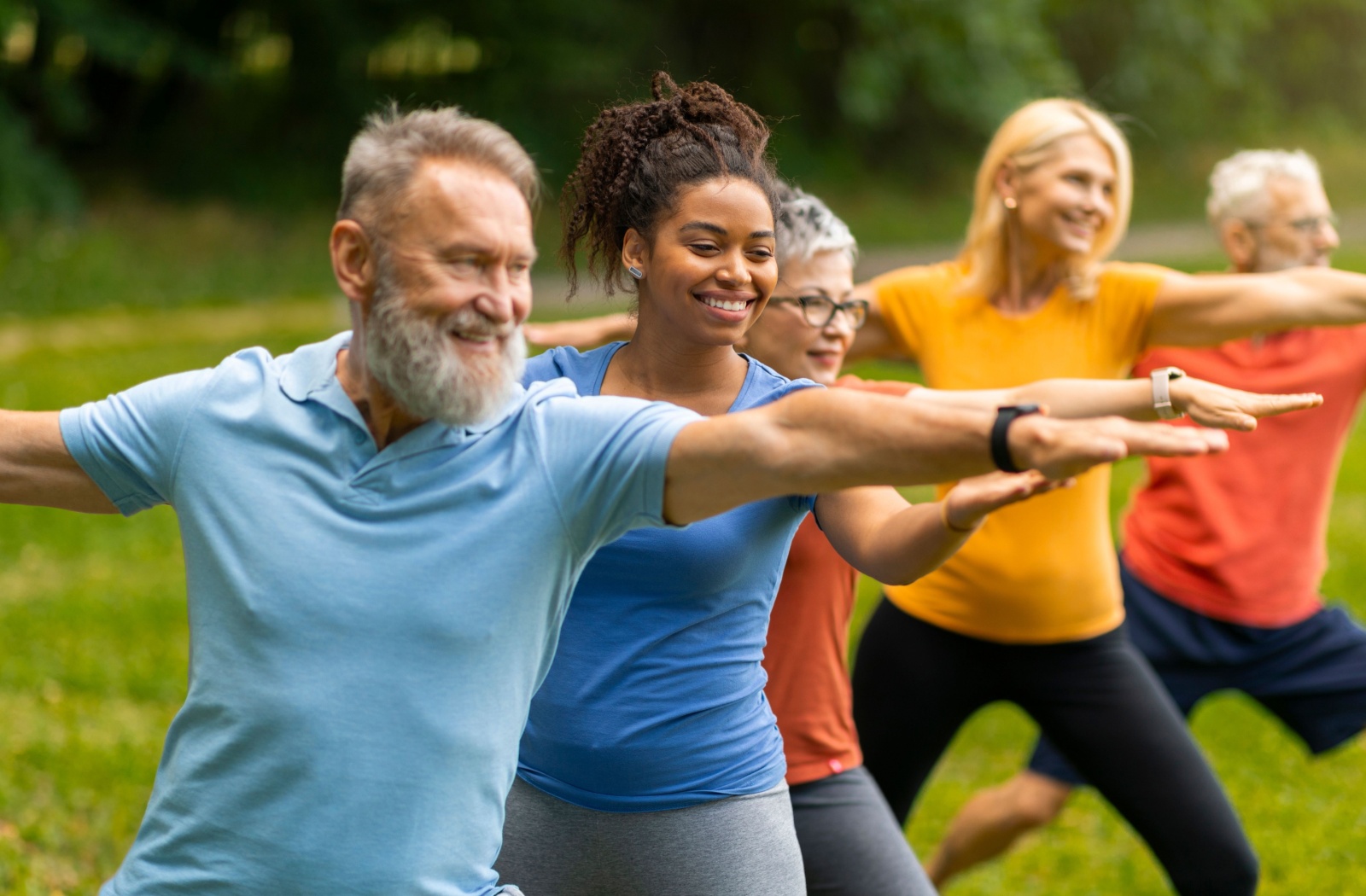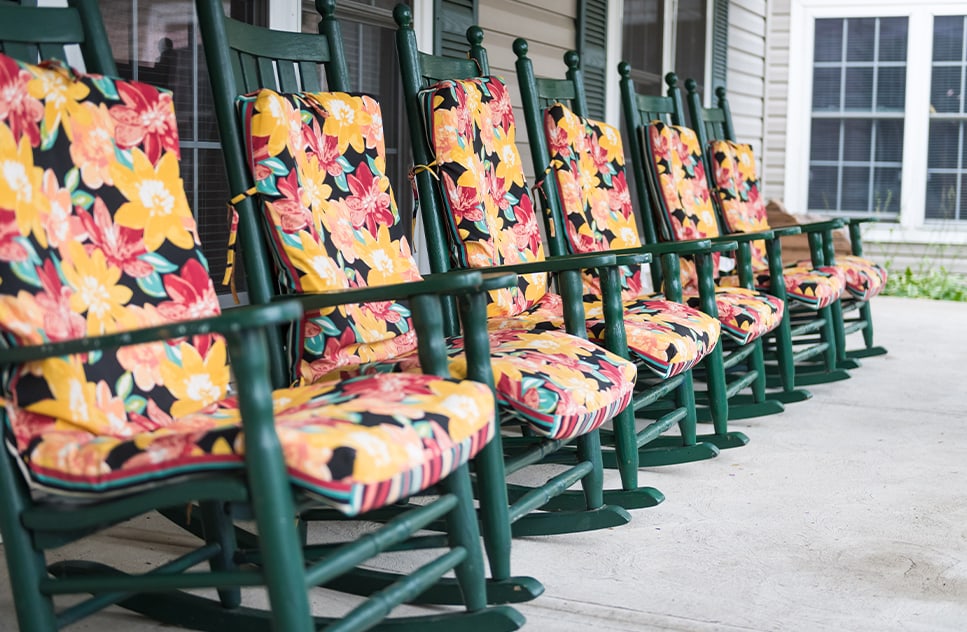Key Takeaways:
- Low-impact movement is best for arthritis relief — exercises like walking, water aerobics, chair yoga, and tai chi help reduce pain without stressing the joints.
- Strength and stretching are just as important as cardio — building muscle around the joints improves stability, while daily stretching reduces stiffness and increases flexibility.
- Seniors with arthritis should aim for 20–30 minutes of gentle activity most days, broken into shorter sessions if needed.
- The safest exercises are slow, controlled, and easily modified — seated variations, resistance bands, and water-based workouts are ideal for seniors with limited mobility or balance concerns.
- Always warm up, start slowly, and stop if pain increases — discomfort is normal, sharp joint pain is not. A doctor or physical therapist should approve new routines.
Arthritis is a common condition that affects many seniors worldwide, leading to joint pain, stiffness, and swelling. While it can make movement challenging and can hinder one’s lifestyle, regular exercise is one of the most effective ways to manage arthritis symptoms. Engaging in gentle, low-impact exercises can increase mobility, reduce pain, and improve overall quality of life and are easy to integrate into senior living.
What Are the Best Exercises for Seniors With Arthritis?
Gentle, low-impact exercises like walking, water aerobics, chair yoga, tai chi, stationary bike cycling, light strength training, and daily stretching can help reduce joint stiffness, increase mobility, and ease arthritis pain. The safest exercises for seniors with arthritis are slow, controlled, and modified to avoid joint strain.
What is Arthritis?
Arthritis is a term commonly used to refer to inflammation of the joints. The two most prevalent forms are osteoarthritis and rheumatoid arthritis. Osteoarthritis is characterized by the gradual wear and tear of joint cartilage, leading to pain and stiffness, while rheumatoid arthritis is an autoimmune disorder where the body’s immune system mistakenly attacks the joint lining, causing inflammation and potential joint deformity.
Arthritis symptoms can vary in intensity and may include swelling, pain, reduced range of motion, and warmth in the affected areas. Despite its prevalence, ongoing research and treatment strategies aim to control pain and improve function, helping those affected maintain an active and fulfilling lifestyle.
Why Exercising Is Important for Arthritis Relief
Exercise is crucial for arthritis relief as it helps maintain joint flexibility, strengthen the muscles surrounding the joints, and ultimately reduce pain. Regular physical activity aids in keeping the joints functional by reducing stiffness and improving range of motion, which can significantly enhance daily living activities. It also promotes good circulation, delivering essential nutrients to the cartilage and joint tissues that support joint health.
Additionally, exercise can help with weight management, reducing the stress on weight-bearing joints and further diminishing the risk of developing additional symptoms. Beyond the physical benefits, exercising can also boost mental well-being, providing a positive impact on mood and stress levels, which can be especially beneficial for individuals managing a chronic condition like arthritis. Here are seven exercises that can help ease arthritis pain in seniors.
1. Walking
Walking is a simple yet effective exercise that most seniors can incorporate into their daily routine. It helps maintain joint flexibility, increases circulation, and strengthens muscles surrounding the joints. Start with short distances and gradually increase the duration and intensity as your body adapts. Ensure you’re walking on even surfaces to minimize the risk of injury, and consider using supportive shoes for added comfort.
2. Swimming and Water Aerobics
Water-based exercises are excellent for seniors with arthritis, as the buoyancy of water reduces the stress on joints while providing resistance to build strength. Swimming or participating in water aerobics classes can enhance cardiovascular health, improve joint flexibility, and reduce pain without putting undue strain on the body. Many local community centers offer classes specifically designed for seniors, making it an accessible option.
3. Yoga
Yoga combines gentle movements, stretches, and breathing techniques to enhance flexibility, balance, and mental well-being. It can be particularly beneficial for arthritis sufferers, as it focuses on improving joint function and reducing stiffness. Look for yoga classes tailored to seniors or those specifically designed for individuals with arthritis. Remember, it’s essential to listen to your body and modify poses as needed to avoid overexertion.

4. Tai Chi
Tai Chi is a traditional Chinese martial art that involves slow, deliberate movements and deep breathing. It promotes relaxation, balance, and flexibility, making it an ideal exercise for seniors with arthritis. Studies have shown that practicing Tai Chi can reduce pain, improve range of motion, and enhance overall physical function in people with arthritis. Many senior centers offer Tai Chi classes, but there are also numerous online resources available for beginners.
5. Cycling
Cycling is a low-impact cardiovascular exercise that can be done outdoors or on a stationary bike. It helps strengthen the muscles around the joints, particularly in the knees and hips, while improving endurance and cardiovascular health. For seniors with balance concerns, a stationary bike is a safer option. Start with short sessions and gradually increase the duration and resistance level over time to avoid straining the joints.
6. Strength Training
Strength training exercises help build muscle mass, which supports and stabilizes the joints, reducing the burden on them. Seniors should focus on low-resistance exercises using lightweight dumbbells or resistance bands. Exercises like seated leg lifts, bicep curls, and wall push-ups can be effective for maintaining joint health and reducing arthritis pain. It’s advisable to consult a physical therapist or fitness professional to design a safe and effective strength training routine tailored to individual needs.
7. Stretching
Regular stretching helps maintain flexibility, reduce stiffness, and increase the range of motion in the joints. Gentle stretches targeting areas affected by arthritis, such as the neck, shoulders, wrists, and knees, can alleviate pain and improve mobility. Set aside a few minutes each day to perform simple stretches, and remember to breathe deeply and move slowly to prevent injury.
Bonus: Chair Exercises for Seniors With Arthritis
For seniors who have limited mobility or discomfort while standing, chair-based exercises offer a safe way to stay active without putting excess pressure on painful joints. These simple movements can be done at home or in a senior living setting and are ideal for easing stiffness, improving circulation, and maintaining strength.
- Seated Marching – Lift one knee at a time while sitting upright to warm up the hips and improve lower-body mobility.
- Seated Leg Extensions – Straighten one leg at a time to strengthen the quadriceps and support knee joints.
- Ankle Pumps & Circles – Point and flex the feet, then rotate the ankles to reduce swelling and improve blood flow.
- Seated Arm Circles – Extend arms out to the sides and make small circles to loosen stiff shoulders and upper-body joints.
- Gentle Seated Press (With or Without Light Weights) – Press hands or light dumbbells upward to maintain shoulder strength and posture.
How Often Should Seniors with Arthritis Exercise?
Most experts recommend 150 minutes of low-impact activity per week, which can be easily divided into 10-15 minute sessions for comfort and safety. It’s important to always consult with your healthcare provider before starting a new exercise regime.
Final Thoughts
While arthritis can pose challenges to physical activity, incorporating these exercises into your routine can significantly improve joint function and reduce pain. It’s essential to listen to your body and start slowly, gradually increasing the intensity and duration of exercises as your fitness level improves.
Consult your healthcare provider before beginning any new exercise program, as they can provide personalized recommendations and ensure your chosen activities align with your overall health plan. At Kingston Healthcare in Vermilion, your wellness is our priority. That’s why we offer physical therapy and exercise programs that can help alleviate arthritis pain. Contact us today to learn more about our programs. By staying active and committed to a regular exercise routine, seniors with arthritis can enjoy a more comfortable and fulfilling lifestyle.






